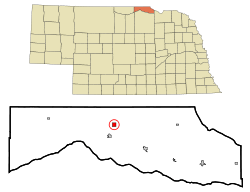Anoka, Nebraska
Anoka is a village in Boyd County, Nebraska, United States. The population was 6 at the 2010 census.[5]
Anoka, Nebraska | |
|---|---|
 | |
 Location of Anoka, Nebraska | |
| Coordinates: 42°56′49″N 98°49′49″W | |
| Country | United States |
| State | Nebraska |
| County | Boyd |
| Area | |
| • Total | 0.56 sq mi (1.45 km2) |
| • Land | 0.56 sq mi (1.45 km2) |
| • Water | 0.00 sq mi (0.00 km2) |
| Elevation | 1,647 ft (502 m) |
| Population | |
| • Total | 6 |
| • Estimate (2019)[3] | 5 |
| • Density | 8.93/sq mi (3.45/km2) |
| Time zone | UTC-6 (Central (CST)) |
| • Summer (DST) | UTC-5 (CDT) |
| FIPS code | 31-01465 |
| GNIS feature ID | 0827002[4] |
History
Anoka was laid out in 1902.[6] The village was named after Anoka, Minnesota.[7]
Geography
Anoka is located at 42°56′49″N 98°49′49″W (42.946914, -98.830244).[8]
According to the United States Census Bureau, the village has a total area of 0.56 square miles (1.45 km2), all land.[9]
Demographics
| Historical population | |||
|---|---|---|---|
| Census | Pop. | %± | |
| 1910 | 145 | — | |
| 1920 | 129 | −11.0% | |
| 1930 | 107 | −17.1% | |
| 1940 | 117 | 9.3% | |
| 1950 | 60 | −48.7% | |
| 1960 | 32 | −46.7% | |
| 1970 | 25 | −21.9% | |
| 1980 | 24 | −4.0% | |
| 1990 | 10 | −58.3% | |
| 2000 | 10 | 0.0% | |
| 2010 | 6 | −40.0% | |
| Est. 2019 | 5 | [3] | −16.7% |
| U.S. Decennial Census[10] 2012 Estimate[11] | |||
2010 census
As of the census[2] of 2010, there were 6 people, 3 households, and 1 family residing in the village. The population density was 10.7 inhabitants per square mile (4.1/km2). There were 6 housing units at an average density of 10.7 per square mile (4.1/km2). The racial makeup of the village was 100.0% White.
There were 3 households, of which 33.3% were married couples living together and 66.7% were non-families. 66.7% of all households were made up of individuals, and 66.7% had someone living alone who was 65 years of age or older. The average household size was 2.00 and the average family size was 3.00.
The median age in the village was 52.5 years. 0.0% of residents were under the age of 18; 33.3% were between the ages of 18 and 24; 0.0% were from 25 to 44; 33.3% were from 45 to 64; and 33.3% were 65 years of age or older. The gender makeup of the village was 50.0% male and 50.0% female.
2000 census
As of the census of 2000, there were 10 people, 3 households, and 3 families residing in the village. The population density was 17.7 people per square mile (6.9/km2). There were 3 housing units at an average density of 5.3 per square mile (2.1/km2). The racial makeup of the village was 100.00% White.
There were 3 households, out of which 66.7% had children under the age of 18 living with them, 100.0% were married couples living together, and 0.0% were non-families. No households were made up of individuals, and none had someone living alone who was 65 years of age or older. The average household size was 3.33 and the average family size was 3.33.
In the village, the population was spread out, with 20.0% under the age of 18, 10.0% from 18 to 24, 20.0% from 25 to 44, 30.0% from 45 to 64, and 20.0% who were 65 years of age or older. The median age was 46 years. For every 100 females there were 66.7 males. For every 100 females age 18 and over, there were 100.0 males.
As of 2000 the median income for a household in the village was $16,250, and the median income for a family was $16,250. Males had a median income of $0 versus $0 for females. The per capita income for the village was $7,625. None of the population and none of the families were below the poverty line.
Notable person
- William E. Forbes, regent of the University of California.
References
- "2019 U.S. Gazetteer Files". United States Census Bureau. Retrieved July 26, 2020.
- "U.S. Census website". United States Census Bureau. Retrieved 2012-06-24.
- "Population and Housing Unit Estimates". United States Census Bureau. May 24, 2020. Retrieved May 27, 2020.
- "US Board on Geographic Names". United States Geological Survey. 2007-10-25. Retrieved 2008-01-31.
- "U.S. Census website". U.S. Census Bureau. Retrieved 4 March 2011.
- Chicago and North Western Railway Company (1908). A History of the Origin of the Place Names Connected with the Chicago & North Western and Chicago, St. Paul, Minneapolis & Omaha Railways. p. 37.
- Federal Writers' Project (1938). Origin of Nebraska place names. Lincoln, NE: Works Progress Administration. p. 5.
- "US Gazetteer files: 2010, 2000, and 1990". United States Census Bureau. 2011-02-12. Retrieved 2011-04-23.
- "US Gazetteer files 2010". United States Census Bureau. Archived from the original on 2012-01-25. Retrieved 2012-06-24.
- United States Census Bureau. "Census of Population and Housing". Retrieved June 23, 2013.
- "Annual Estimates of the Resident Population: April 1, 2010 to July 1, 2012". Archived from the original on October 19, 2013. Retrieved June 23, 2013.